For guaranteed snow in Italy, this is the place to come. Penny Wainwright samples the delights of the Matterhorn from the Italian side…
Breuil-Cervinia, a ski resort in the Valle d’Aosta, is two hours by coach from Turin. The road through the Valtournenche goes between mountains of bare rock with ancient monasteries seeming to grow from them. The final part of the journey consists of hairpin bends and increasing amounts of snow, incredible views both back down the valley and up towards the ski resort. Excitement rises as the Matterhorn appears at the head of the valley, the white peak stark against the blue sky.
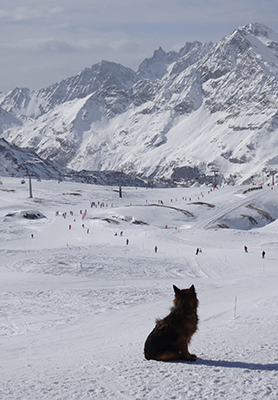
Breuil-Cervinia is unlike other mountain resorts, being a relatively modern town developed following the building of a modern road and lift systems in the 1930s.
The small town was first called ‘Mons Silvanus’ by the Romans, meaning ‘forested mountain’. The town was later known as Breuil, which meant ‘land of many waters’ in the local dialect. Before 1865 few people visited Breuil, except for mountaineers attempting to climb the Matterhorn. The town’s name was changed again to Cervinia when Benito Mussolini wanted a more Italian name. I
n the centro storico, the oldest buildings consist of a few old houses and a small church dating back to 1759. The church is located behind the current parish church and is dedicated to ‘Our Lady of the Hermits and of Snow’.
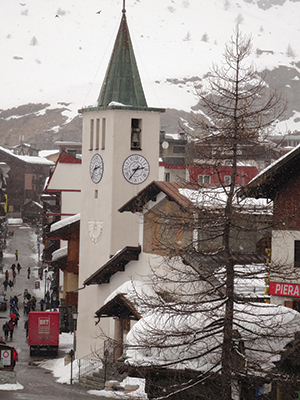
The morning after our arrival I hurried to get ready and head to the cable car to go to the first lift station, Plan Maison. I went down a short blue run to find my ski legs before taking a lift to Theodulpass. Skiing down to Plan Maison on a red run was like floating over the snow, with space to breathe in the cool air and time to take in the wonderful views around me.
Another lift took me to Laghi Cime Bianche, which led me onto the Ventina piste. I relished in the joy of being back in the mountains. The Cervino ski area is an ideal resort for beginners and intermediates with wide open pistes and plenty of restaurants to take in the views over an espresso.
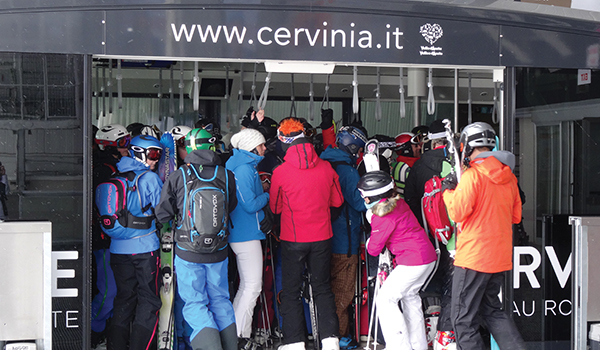
After lunch, I took the cable car to the glacier on Plateau Rosà. From the lift station at the top of the mountain there are runs leading to Zermatt in Switzerland. As the lifts can close due to high winds or difficult weather conditions, it is advisable to stay alert to changes in the weather when skiing on the Swiss side of the mountain.
The highest museum in Europe, ‘A Mountain at Work’, is in an unassuming building a short walk up from the Plateau Rosà lift station. It records the building of the first lift system in Cervinia. In the museum, there are collections of photographs and artefacts showing the construction of the first part of the lift system to Plan Maison in 1936.
The cable car to the glacier at Plateau Rosà was built in 1939. I was fascinated by the reproductions of paintings of the Matterhorn in the museum. Many poets and artists have been inspired to create their interpretation of this iconic mountain, including Pablo Picasso and Salvador Dalí. John Ruskin referred to it as “the most noble rock in Europe”.
Wine tasting
That evening I went to a wine tasting at Lo Copa Pan restaurant and bar in the town. The restaurant has been open since 1959. The current owner, Mirco Lombard, has tried to create a modern take on the traditional dishes. He has established strong traditions of using local ingredients sourced from nearby farms. His family have lived in Cervinia for a long time and his great, great grandfather was Jean-Baptiste Bich, one of the Italian climbers who reached the summit of the Matterhorn in 1865.
Vincenzo hosted the wine tasting, introducing wines and accompanying dishes and talking about their history. There are four foods produced in the Aosta Valley which have a DOP (Denominazione di Origine Protetta) mark: Fontina and Fromadzo cheeses, Jambon de Bosses (cured ham) and Lard d’Arnad (fat from wild boar).
The origins of some of the restaurant dishes are the simple foods that were eaten many years ago, such as zuppa val pellinetze. This was a soup made with cabbage and stock, old bread and cheese which has translated into seuppa alla valpellenentse in the restaurant. Layers of bread, cheese, cabbage and beef broth are cooked slowly in the oven until the cheese has melted and the broth has been soaked up by the bread. The restaurant’s name, Lo Copa Pan, refers to the bread chopping board which has been handed down through the generations and is used for cutting the old or hard bread.
Five wines from the Valle d’Aosta were provided for the tasting. The first was a blush wine made from pinot noir grapes. It was a fresh, dry, fruity wine and very easy to drink. When Vincenzo asked his grandfather how to choose the best wines, his grandfather replied, “The best wine is like a lady, it’s up to you to choose the one that suits you best” – good advice, as we all have different tastes, even when drinking wine. The white wines that followed were refreshing after the cheeses and meats. The final wine, Torrette VDA, was a full-bodied red wine blended from syrah, mayolet and fumin with the spicy flavour coming from the fumin grapes.
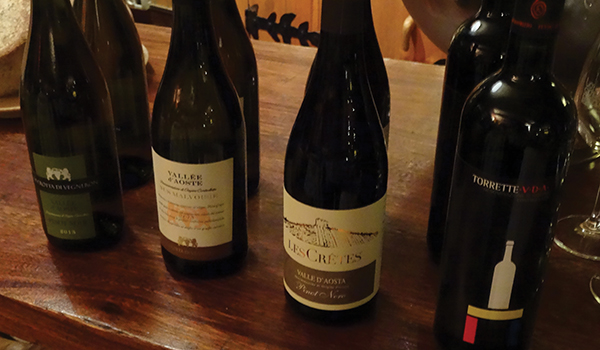
The following morning, I met Paolo, a ski instructor from one of the five ski schools, Ride’Em. I was able to talk to him at Plan Maison while he waited for his group to arrive. Paolo had lived in Cervinia since 1971 and says he has seen many changes to the lift system and equipment being used in the last 45 years. Initially, he tells me, there were mainly skiers – both downhill and cross country skiers – but today there are ever increasing numbers of snowboarders here. Also, in Paolo’s early days, the skiers were mainly Italian, British and Swedish, but now people come from all European countries, as well as Australia and South Africa.
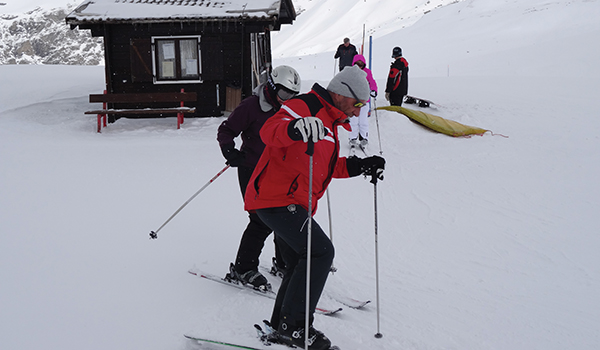
The first ski club in Italy was formed in 1910 in Turin and the Cervino ski club formed a year later. The Scuola di Sci Cervino was the first ski school to be established in Cervinia, in 1936. 2016 saw the ski school celebrating its 80th anniversary. Their first brochure contained the names of the instructors and prices for the lessons – fourteen lire for one group lesson compared to today’s price of €38 per lesson. The sport developed further in the 1960s when more tourists began arriving in Cervinia. In 1991 snowboards began to appear. There is a snow park, Indianpark, in the Plan Maison ski area and this winter season international snowboarders will again be competing here.
Happy and blessed
Before beginning to ski, I went into the restaurant Lo Stombecco, above the Plan Maison station, for a hot chocolate and saw a quote from Lord Byron around the walls. Byron loved the mountains and his words (roughly translated) remain with me: “Happy is he who on these mountains could long rest. Blessed is he who sees them again, if he had to leave,” (an extract from Childe Harold’s Pilgrimage).
Back into the sunshine, I planned to ski to Valtournenche. Taking a chair lift to Laghi Cime Bianche, I retraced my path from the day before down the red run. After another chair lift to Lago Goillet, I was able to ski the Gran Pista di Valtournenche. The weather and snow conditions were perfect and there were very few people on the run. I loved racing down the slopes towards through the trees and the tunnel leading to Valtournenche. A lift back up the mountains took me onto new pistes and, as I skied back to Cervinia, I enjoyed the empty pistes with confident legs leading me over the snow.
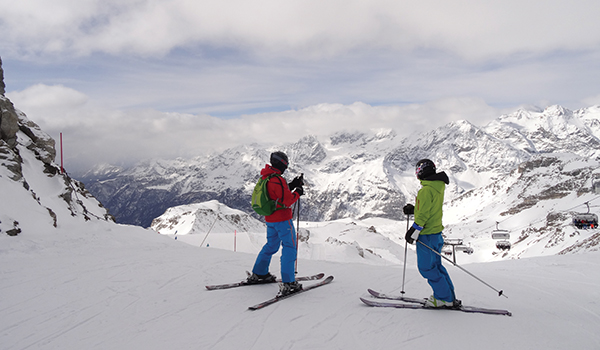
Back in the town I met Luca, my guide from the local tourist office. We visited the Museum of Matterhorn Mountain Guides to see ‘Ridges and faces of the Matterhorn: 150 years of mountaineering history 1865-2015’. This is an exhibition commemorating the first ascents of the mountain. On the 14th of July 1865, Edward Whymper, an English climber, reached the summit with his guides from the Swiss side. The Italian climbers led by Jean-Antoine Carrel, who were hampered by dangerous weather conditions on the Italian side, did not reach the summit until three days later. Sadly, four of the climbers were killed on their descent. Carrel’s cross now marks the start of the ascent.
Outside the museum, Luca pointed out the Golf Club del Cervino, which opened in 1955. The 18-hole course is opposite the museum and is open from June to September. The course was hidden by the winter snow, and a cross country track. I watched four Swedish cross country skiers racing around the track. With snow starting to fall, I headed into a bar for a final après-ski drink. Nibbling on local cheese and meats, I sipped a glass of vin brûlé and reflected that Cervinia has more pistes for me to ski and more restaurants for me to try next time I am here.
